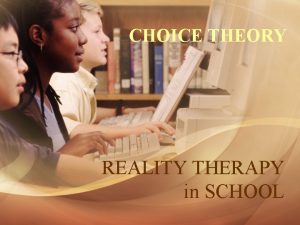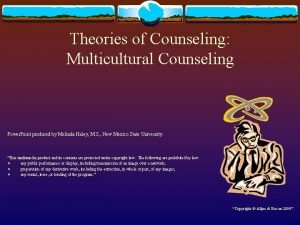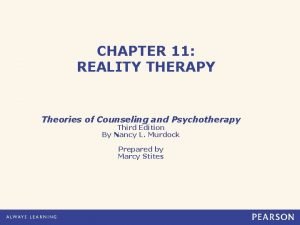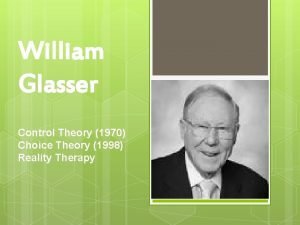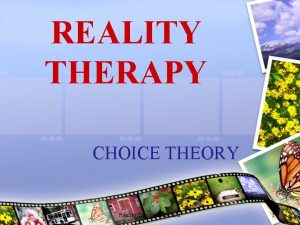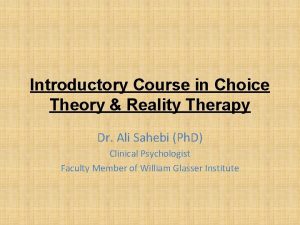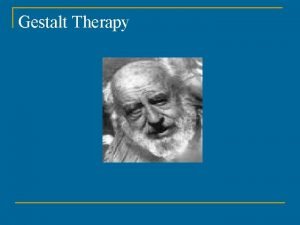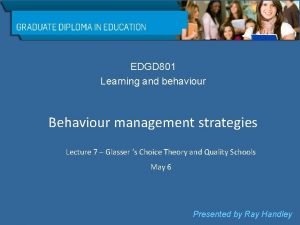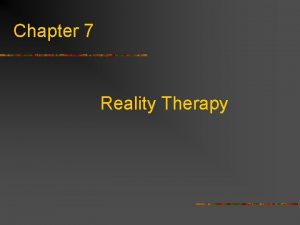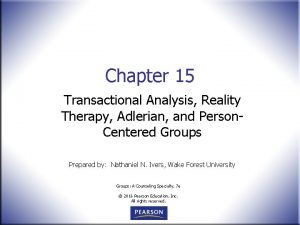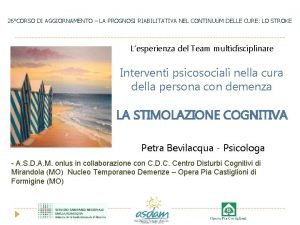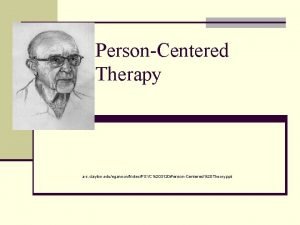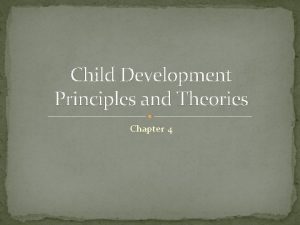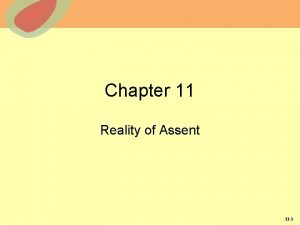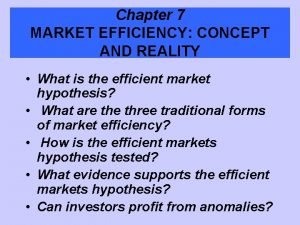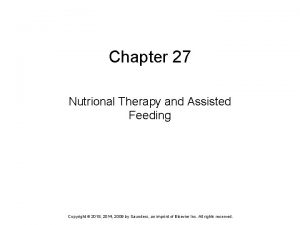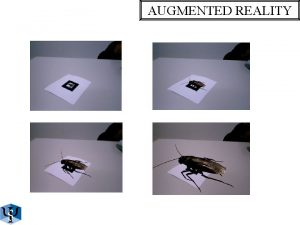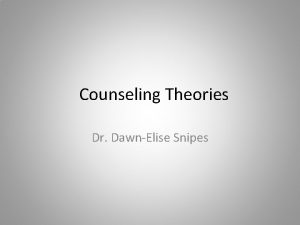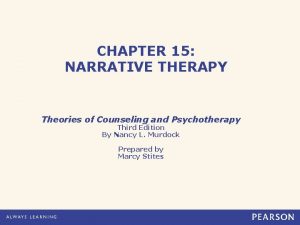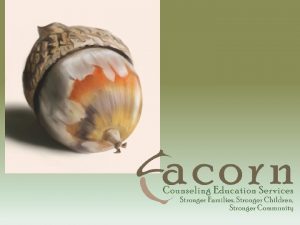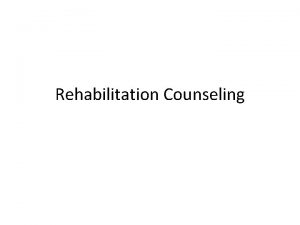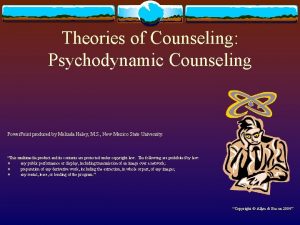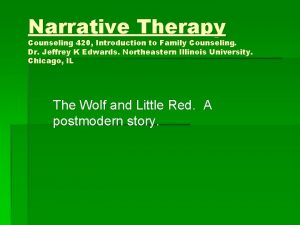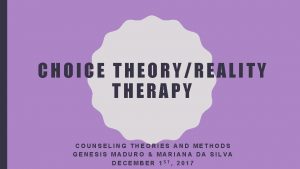CHAPTER 11 REALITY THERAPY Theories of Counseling and





















- Slides: 21

CHAPTER 11: REALITY THERAPY Theories of Counseling and Psychotherapy Third Edition By Nancy L. Murdock Prepared by Marcy Stites

William Glasser (born 1925) Murdock. Theories of Counseling and Psychotherapy, 3 e. © 2013, 2009, 2004 by Pearson Education, Inc. All Rights Reserved 11 -2

Case Study “Donald” Murdock. Theories of Counseling and Psychotherapy, 3 e. © 2013, 2009, 2004 by Pearson Education, Inc. All Rights Reserved 11 -3

Highlights of Glasser and RT • Like others, grew out of Glasser’s dissatisfaction with traditional psychoanalytic theory • Born 1925, son of immigrant parents, Cleveland, OH – Board certified in psychiatry, 1961 – Ventura School for troubled girls and Reality Therapy (1965) • www. wglasser. com Murdock. Theories of Counseling and Psychotherapy, 3 e. © 2013, 2009, 2004 by Pearson Education, Inc. All Rights Reserved 11 -4

Background (cont. ) • In 1996 Glasser radically revised RT theory to emphasize the importance of relationships • Changed theory underlying RT from control theory to choice theory • Robert Wubbolding (2011 a) heads Center for Reality Therapy • International Therapy Journal of Choice Theory and Reality Murdock. Theories of Counseling and Psychotherapy, 3 e. © 2013, 2009, 2004 by Pearson Education, Inc. All Rights Reserved 11 -5

“Choice theory teaches that we are much more in control of our lives than we realize. ” Glasser, 1998 Murdock. Theories of Counseling and Psychotherapy, 3 e. © 2013, 2009, 2004 by Pearson Education, Inc. All Rights Reserved 11 -6

Basic Philosophy • Essential nature of humans is positive • Social constructivist – “real world” is defined by consensual agreement • People are in the driver’s seat – they choose their own behaviors • Anti-psychotropic – one has choices Murdock. Theories of Counseling and Psychotherapy, 3 e. © 2013, 2009, 2004 by Pearson Education, Inc. All Rights Reserved 11 -7

Human Motivation • Maximize pleasure and minimize pain – satisfaction of basic needs (survival, love and belonging, power, freedom, and fun) Murdock. Theories of Counseling and Psychotherapy, 3 e. © 2013, 2009, 2004 by Pearson Education, Inc. All Rights Reserved 11 -8

Central Constructs • Basic Needs – Survival, love and belonging, power, freedom, and fun—are innate and universal – Love and belonging is the most important need • All behavior represents our best effort to satisfy needs • Quality World: set of mental images of need-fulfilling things or people – Begins shortly after we’re born and revised continuously over our lifetimes – Mother is the first person in the quality world Murdock. Theories of Counseling and Psychotherapy, 3 e. © 2013, 2009, 2004 by Pearson Education, Inc. All Rights Reserved 11 -9

Continued… • Total Behavior: multidimensional nature of human behavior (acting, thinking, feeling, and physiology) – Acting and thinking are under our control and can be influenced by feelings and physiology – Choice Theory: 10 axioms – “we choose everything we do” ○ External control by the environment • 3 basic beliefs underlie external control • 7 deadly habits of external control • 7 caring habits Murdock. Theories of Counseling and Psychotherapy, 3 e. © 2013, 2009, 2004 by Pearson Education, Inc. All Rights Reserved 11 -10

Goal • To meet our needs in a constructive mean Murdock. Theories of Counseling and Psychotherapy, 3 e. © 2013, 2009, 2004 by Pearson Education, Inc. All Rights Reserved 11 -11

Theory of Person and Development • “Personality” based on relative strengths of a person’s basic needs • No formal theory of personality development – “seeds of unhappiness are planted early” – Parents or other powerful people are key to trust Murdock. Theories of Counseling and Psychotherapy, 3 e. © 2013, 2009, 2004 by Pearson Education, Inc. All Rights Reserved 11 -12

Health • Healthy: are advocates of choice – Being happy without violating the rights – Able to satisfy their own needs – Having satisfying personal relationships Murdock. Theories of Counseling and Psychotherapy, 3 e. © 2013, 2009, 2004 by Pearson Education, Inc. All Rights Reserved 11 -13 of others

Dysfunction is failure to satisfy one’s needs • “ing” • choosing behavior (i. e. , depressing) Make bad choices • Loneliness • Effectiveness in soliciting help • Avoids tougher alternatives – facing problems and risking rejection • Psychotic behavior seen as bad choices in attempting to meet needs • Dysfunction happens when individual feels disconnected from others • Three stages of healthy and unhealthy behaviors (Wubbolding, 2011 a) Murdock. Theories of Counseling and Psychotherapy, 3 e. © 2013, 2009, 2004 by Pearson Education, Inc. All Rights Reserved 11 -14

Nature of Therapy • Assessment: none are used other than figuring out what relationship(s) is (are) problematic – Critical of formal diagnosis • Therapeutic Atmosphere – Counselor wants to become a picture in the client’s quality world – Meeting the client’s love and belonging needs – Displays empathy, genuineness, and positive regard – Active, focused on behavior and thinking – Centered in the present and reality based, short term – AB-CDE Murdock. Theories of Counseling and Psychotherapy, 3 e. © 2013, 2009, 2004 by Pearson Education, Inc. All Rights Reserved • Roles – Counselors ask a lot of questions and challenge client to evaluate behavior – Resemble doctor-patient – Taught about choice theory – Client must accept responsibility in counseling sessions • Goals: make better choices – Reconnect to critical relationship(s) – Changing feelings for clients by making more effective acting and thinking choices 11 -15

Process of Therapy • RT is process oriented – what to do now and how the client can make new choices • Do not spend a lot of time on client’s symptoms, transference or countertransference • WDEP process: Wants, Direction, Effective, Plans • 8 -step approach to RT – Involvement – Focus on Present Behavior – Value judgment – Planning responsible behavior – Commitment to the plan – Accept no excuses – Do not punish – Never give up Murdock. Theories of Counseling and Psychotherapy, 3 e. © 2013, 2009, 2004 by Pearson Education, Inc. All Rights Reserved 11 -16

Techniques • Teaching Choice Theory • Process of discussion leading to – Identifying problematic need-related behavior and choosing functional behavior – Questioning – Bibliotherapy – Doing the unexpected – Reframing – Humor – Self-disclosure – Metaphors – Physical activity and meditation – Allowing or imposing consequences Murdock. Theories of Counseling and Psychotherapy, 3 e. © 2013, 2009, 2004 by Pearson Education, Inc. All Rights Reserved 11 -17

Evaluation of the Theory • Evaluation of the Theory – Relatively simple and easy to understand, possibly too simple – Faulted for ignoring social influences on behavior • Qualities – Operationalizing is difficult – Empirical support is weak • Research Support – Outcome studies have shown theory’s effectiveness – Methodological error in many of the studies, no randomly controlled trial • Theory-testing are few – Ryan and Deci (2008) and La. Fond (2000) Murdock. Theories of Counseling and Psychotherapy, 3 e. © 2013, 2009, 2004 by Pearson Education, Inc. All Rights Reserved 11 -18

Individual and Cultural Diversity • Too Heterosexual • Subject • Needs to choice is problematic are culturally bound • Some research evidence suggests RT may be a very acceptable approach for diverse clients Murdock. Theories of Counseling and Psychotherapy, 3 e. © 2013, 2009, 2004 by Pearson Education, Inc. All Rights Reserved 11 -19

Summary • People are motivated to meet their basic needs of survival, love and belonging, fun, freedom, and power. • Love and belonging is the most important • Dysfunction results in bad choices • Therapy is about planning for the client to choose a different way to meet their needs • Research base spotty, dated but likely it can be considered an effective psychotherapy approach Murdock. Theories of Counseling and Psychotherapy, 3 e. © 2013, 2009, 2004 by Pearson Education, Inc. All Rights Reserved 11 -20

Conclusion Life is about meeting basic needs Murdock. Theories of Counseling and Psychotherapy, 3 e. © 2013, 2009, 2004 by Pearson Education, Inc. All Rights Reserved 11 -21
 Reality therapy in school counseling
Reality therapy in school counseling Theories of multicultural counseling
Theories of multicultural counseling 11 theories of counseling
11 theories of counseling Reality therapy questions
Reality therapy questions Reality therapy questions ask client
Reality therapy questions ask client Reality therapy questions
Reality therapy questions Reality therapy examples
Reality therapy examples Reality therapy questions
Reality therapy questions Reality therapy examples
Reality therapy examples Reality v chapter 7
Reality v chapter 7 Transactional analysis group therapy
Transactional analysis group therapy Schede rot formale
Schede rot formale Reality therapy ppt
Reality therapy ppt Counseling vs therapy
Counseling vs therapy Both psychoanalysis and humanistic therapy stress
Both psychoanalysis and humanistic therapy stress Bioness integrated therapy system price
Bioness integrated therapy system price Humanistic therapies aim to boost
Humanistic therapies aim to boost Child development principles
Child development principles Firm based trade theory
Firm based trade theory Reality v chapter 11
Reality v chapter 11 Reality v chapter 7
Reality v chapter 7 Chapter 27 nutritional therapy and assisted feeding
Chapter 27 nutritional therapy and assisted feeding
